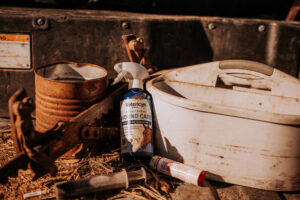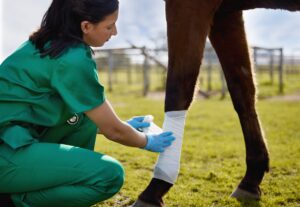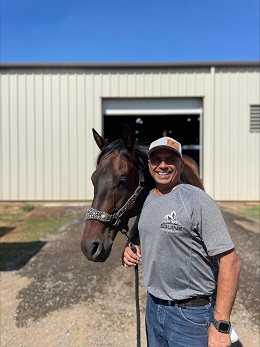When riding and working with horses, anything can happen in the course of a day. It’s always better for a horse owner to be prepared ahead of time than to feel regret later on, especially when it comes to animals who fully rely on you for their care and well-being.
Emergency care starts in your barn, well before the vet arrives. Without the proper preparation and treatment, minor wounds can quickly become serious ones.
A key part of your horse’s health is a reliable equine first aid kit. Below, we’ve developed a go-to guide on first aid essentials, learning how to treat a wound, and emergency readiness.
Why Do I Need a First Aid Kit?
The reasons you’ll need a horse first aid kit are often incidents you don’t expect to happen but have to be ready for. For instance, imagine that your mare gashes her flank on a fence post or walks right into a bee’s nest. Perhaps your horse goes to bed feeling fine but wakes up the next morning with an upset stomach or a skin rash.
From minor to major emergencies, as a horse owner you want to be prepared for any situation, including1:
- Cuts and scrapes
- Bruises
- Colic in horses
- Abscesses (more specifically abscesses in horse hooves)
- Rashes and skin sores
- Burns and hot spots
- Inflammation
Of course, there are many other types of illness and infection. If it seems serious, it’s always best to consult with your vet.
Must-Haves for Equine First Aid Kit
If you live in a remote area, it may take your veterinarian a while to arrive. In the meantime, you need to be prepared with the basics. Let’s go through all the types of equine first aid.
Basic Supplies
These emergency items and tools should be in every equine first aid kit. No matter the situation, these equine kit contents are sure to come in handy1:
- Stethoscope – To monitor heart rate
- Rectal thermometer – For quick fever checks
- Lubricant – To insert the thermometer
- Rubbing alcohol – To disinfect the thermometer
- Latex gloves – To protect your hands
- Scissors – specifically bandage scissors, To cut bandages and gauze
- Sharp knife – To cut wire or rope
- Clean towel – For a sanitary space
- Clean bucket – For hoof soaking or wound washing
- Flashlight or headlamp – For after-dark emergencies
You may have many of these items on hand already or even in a human first aid kit. It’s always advisable to have medical supplies for yourself as well, but kept separate from your horse first aid kit contents.

Wound Care
Some of the most common everyday injuries are minor wounds like cuts, scrapes, punctures, and sores. If your horse is not profusely bleeding, and you don’t think an injury is related to an underlying fracture or break, oftentimes you can treat the wound yourself.
Here are the supplies you’ll need:
- Bandages
- Gauze
- Duct tape
- Antiseptic or disinfectant (like Betadine)
- Saline solution
- Equine Wound and Skin Care Liquid
How to Bandage a Wound
Always call your vet to describe the wound, even if you don’t need them to come. You’ll at least get some expert advice plus the peace of mind to treat the wound at home.
Here are the steps to follow2:
- Bring your horse to a safe place. Lead your horse away from other animals on the property. Get them comfortable in a clean stall, or lay down a fresh towel.
- Stop the bleeding. Apply steady pressure to the wound with a gauze bandage until the blood stops soaking through.
- Clean the wound. Put on gloves to avoid contamination and begin flushing out the wound with warm water. Saline solution is useful for cleaning facial wounds, especially near the eyes and nose. Don’t use a hose, as the high pressure might cause more damage. At this step, you can use a disinfectant like Equine Wound and Skin Care Liquid, made with a non-toxic, antibiotic-free formula to help prevent infection.
- Bandage the wound. Apply an antimicrobial hydrogel or thicker dressing gel to promote healing. Place a layer of gauze on the wound, then wrap the area with a bandage. Pro tip: duct tape is waterproof and durable, so you can use it on top of the bandage to keep it more secure.1
- Monitor the injury. Pay close attention to your horse’s behavior in the next few days. If the bandage falls off, put on a new one to avoid dangerous contamination from dirt or debris. In the case of inflammation, apply a cold compress.1 If the wound reopens, your horse develops lameness, or bleeding continues, consult with your vet immediately.
Keep in mind that these recommendations do not apply for deep gashes and profuse bleeding that may require suturing, or if your horse has broken a bone. In these cases, seek professional veterinary attention immediately.
Other First Aid Supplies
In addition to wound care tools, your equine first aid kit should be equipped with supplies for other injuries or medical issues. These equine care items include:
- Eye ointment – For eye inflammation, pink eye, scratched corneas, and other infections, an ointment should be applied around the affected area. We recommend the Vetericyn Antimicrobial Eye Care Kit, a 2-step eye wash and ophthalmic gel to clean and relieve eyes.
- Electrolyte paste – If injury or illness has made a horse lethargic and dehydrated, electrolytes are an easy way to improve their energy levels and promote recovery. This is especially useful in the hot summer months. Just be sure to consult with your vet regarding the proper dosage.1
- Cold packs – Just like for humans, ice packs help reduce swelling and inflammation, and can keep a horse more comfortable during the healing process. Cold packs are useful for cuts, scapes, sores, and rashes.
- Hoof pick – Hoof picks should already be a part of everyday hoof cleaning, and they’ll also come in handy if your horse gets a stone, nail, or piece of wood stuck in their foot. Leaving debris in the hoof can lead to infection or injury.
- Hydrogel – A non-toxic spray like the Vetericyn Antimicrobial Hydrogel can help soothe and protect cuts, sores, rashes, and burns. The hydrating gel offers cool relief while simultaneously keeping the wound clean and providing a protective barrier against infection.
Phew! That’s a lot of supplies. Make sure to keep everything organized in one box—you don’t want to waste time searching for items when it’s time to help your horse.
What to Do in an Emergency
It is often said that it’s not if a horse will be injured, but when. Here are three tips on safely handling the situation2:
- Remain calm. If you panic, you may stress out your horse and make them more likely to exacerbate their injury. Plus, a clearer head will help you act quickly and efficiently while giving care.
- Call the vet. Even if they don’t wind up coming out to see your horse, it’s still ideal to keep them informed along the way.
- Ask for help. If a horse is in pain, it might try to resist your efforts. Having another person there with you can come in handy, as one of you can keep the horse calm and still while the other tends to the wound.
Grab your equine first aid kit, and with a little TLC, your horse should be ready to ride again in no time.

Tips for Emergency Preparedness
There are many ways to set yourself (and your horse) up for success, before even opening the first aid kit. Proactive measures like these will buy you precious time in an emergency and also help you keep your cool:
- Save emergency contact information – Save the veterinarian’s and farrier’s phone numbers, and keep a hard copy of this info in your stables.
- Restock low supplies – Replace items as soon as you notice you’re getting low, not when it’s already too late. (Don’t forget to check the batteries in your flashlight!)
- Replace expired products – You should always use medications at their full potency, not once they’ve passed the best-by date.
- Store health records – Keep all important documents in a safe place in case your vet ever requests them.
- Practice, practice, practice – You should know how to use every item in the equine first aid kit. Practice the things you’re less confident in, whether that’s using the rectal thermometer or wrapping up a hoof.
With these tips and a calm mindset, you’re ready to show up for your horse as the best caregiver you can be.
Fortify Your First Aid Kit with Vetericyn
At Vetericyn, we’re committed to providing safe, high-quality animal wellness products to farmers and pet owners nationwide. When planning your equine first aid kit, look no further than our expert wound care products.
Our expert-designed process is two-fold: First, clean a wound with the Antimicrobial Equine Wound and Skin Care Liquid. Then, apply a healing gel, either our Antimicrobial Hydrogel or the thicker Dressing Gel.
While you’re here, check out other equine products that both treat damage and prevent future injury. Our Equine Liniment helps reduce swelling, stiffness, and muscle pain, while the Vetericyn Hoof Care and Hoof Soak remove microorganisms, strengthen the hooves, and minimize the risk of infection.
Head to your local equine supply store today, or order online from major retailers including Amazon and Tractor Supply.
 Reviewed by Solomon Benarroch, Veterinarian
Reviewed by Solomon Benarroch, Veterinarian
Solomon Benarroch DVM has been a practicing veterinarian for over 30 years. His primary focus has been in equine soundness and performance sports medicine. Originally from Winnipeg, Canada he attended college at the Western College of Veterinarian Medicine. And completed an internship at the University of Minnesota. He is the father of three kids and when he isn’t working (which is rare), he enjoys traveling, cooking, and spending time with friends and family.
Sources:
- Practical Horseman. Equine First-Aid Essentials. https://practicalhorsemanmag.com/health/equine-first-aid-essentials/
- Blackdown Equine Clinic. Wound Care Fact Sheet. https://blackdownequineclinic.com/wp-content/uploads/2017/12/Wounds_Fact_Sheet.pdf